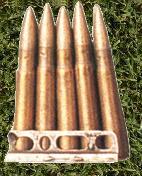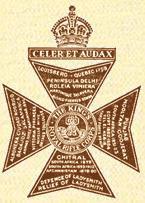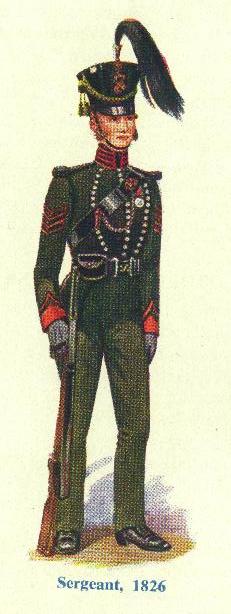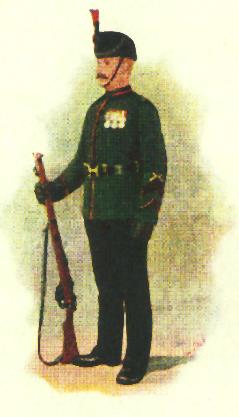




A BRIEF HISTORY OF THE KRRC FROM 1755 TO 1936
The Regiment was formed in 1755 in America as the “60th Royal American Regiment” to fight the French. The less conspicuous uniforms, loose battle drill and fast movement of the unit proved invaluable in the dense terrain in Canada where the French and Red Indians had been decimating the regular red-coated Infantry with their tight battle formations. It was later renamed as a ‘Corps’ rather than a Regiment as there have always been several battalions in the unit. ‘Regiment’ can imply only one battalion.
NORTH AMERICA AND THE WEST INDES, 1755-1796
The 60th Royal Americans fought the French and Red Indians in the Seven Year’s war. The 2nd and 3rd battalions played a leading role in the capture of Quebec, earning them the motto “Celer et Audax” or “Swift and Bold”. The Corps was present at the final French surrender in 1760. The war with the Red Indians dragged on for 4 more years. The 1st battalion inflicted a crushing defeat upon them in 1763 which soon ended the war.
During the American Civil War, all four battalions were in the West Indies, in which they played a decisive role in capturing these islands from the French and Spanish. Although the title of the regiment was not officially changed until 1824, the Regiment was called the 60th Regiment of food after the American colonists deserted… ahem! er… ‘gained independence’.
WAR WITH FRANCE, 1797-1815
A fifth battalion was raised from the ranks of our allies, the Hanovarians, Austrians and Swiss to fight the French alongside the existing 4 battalions. The regiment Was now equipped with rifles and swords rather than the short musket and bayonet of the rest of the army. Radical changes were introduced in dress, tactics and discipline that proved their worth on all battlefields of the Peninsula.
From this point on, black buttons and the Hunter’s horn were introduced to the battlefield, the latter later becoming the insignia of the Royal Greenjackets (which included the King’s Royal Rifle Corps).
In one letter of the war, from Marshal Soult, declared that the extremely high losses in the French army were due to a battalion of the 60th rifles which had a company attached to each division. He wrote that “their men were selected for their marksmanship, armed with a short rifle and act as scouts” and that “they pick off the officers, including Generals and staff” and that “this method of making war is very detrimental to us”. In 1824, the Regiment was renamed “The 60th, Duke of York’s Own Rifle Corps. In 1830, it was again renamed “The 60th, King’s Royal Rifle Corps”.
SMALL WARS, 1848-1895
For nearly 50 years the Regiment was engaged in a long series of minor wars to keep the peace in the colonies. The regiment fought in India, South Africa, Canada, Burma, Afghanistan and China. I would like to stress that, contrary to common belief, the British presence in such conflicts was that of a peacekeeping role or combat with other large nations and not any kind of brutal colonial repression. Schools and healthcare were introduced to impoverished countries, the regions had stability that could only be dreamt of before the British presence and personal liberties were as good as they were anywhere in the world at that time.
The 1st battalion was “pre-eminent in the memorable siege and capture of Delhi” (1857), winning 7 Victoria Crosses. The Governor-General of India, Lord Canning, wrote that “The cheerfulness, steadiness and high qualifications of skirmishers of the 60th rifles were beyond commendation”. The 2nd Gurkhas asked to be able to be called riflemen and to wear the same uniform as the 60th, so impressed had they been with the conduct of the 60th, alongside whom they had fought for four monthson the famous ridge norht-west of Delhi.
From 1880 the 60th played a leading part in the creation of mounted infantry and its training. The Greenjackets found a large number of their officers seconded from the regiment for this purpose. In 1881, the regiment was renamed “The King’s Royal Rifle Corps”.
SOUTH AFRICAN WAR, 1899-1902
All four battalions and the 9th militia battalion fought in this war. The 1st Battalion distinguished itself at the battle of Talana Hill, afterwards joining with the 2nd battalion in the siege of Ladysmith. The 3rd battalion, forming part of the relief force, gained special credit in its capture of the Twin Peaks at the battle of Spion Kop. A reserve rifle battalion, consisting of reinforcements for all four battalions, also took part in the battle of the relief of Ladysmith.
Mounted infantry was formed from the 1st and 2nd battalions at the beginning of the war and later from the 3rd and 4th. For the last eighteen months, all mounted units from each battalion were united into the 25th Mounted Infantry, which was continually in the field until hostilities ceased.
29 Officers and 576 other ranks laid down their lives in this war. Two VCs were awarded.
THE FIRST WORLD WAR, 1914-1918
Seventy-one battle honours were added to the Regimental list in this conflict, Nine VCs were awarded and 13,000 officers and men were killed or died. Over 123,000 were wounded. The regiment fought on the Western, Italian and Macedonian fronts and one company was sent to Russia to fight the Bolsheviks.
The 1st and 2nd battalions fought in Belgium all through the war. Fourteen Battalions fought at the Somme, 1916, sustaining 4,200 casualties all ranks. The 4th and 3rd, including a Rhodesian platoon, suffered particularly badly in France in 1914 and 1915, and were sent to the Macedonian front for three years. The 4th returned to France after the collapse of Russia and the 3rd marched on Constantinople and took part in the final battle that eliminated Bulgaria from the war. The 18th and 21st were sent to the Italian front in the winter 1917-18.
Soon after the war, the KRRC was reduced to 4 battalions. In 1922, the 3rd and 4th, 66 years in existence, were disbanded.
KRRC rifleman, full dress, 1890-1939.
Adapted with permission by David Blatcher from “The King’s Royal Rifle Corps (60th Rifles) Bicentenary Edition”, published 1955, which was kindly supplied by Colonel I H McCausland of the Celer et Audax club.


